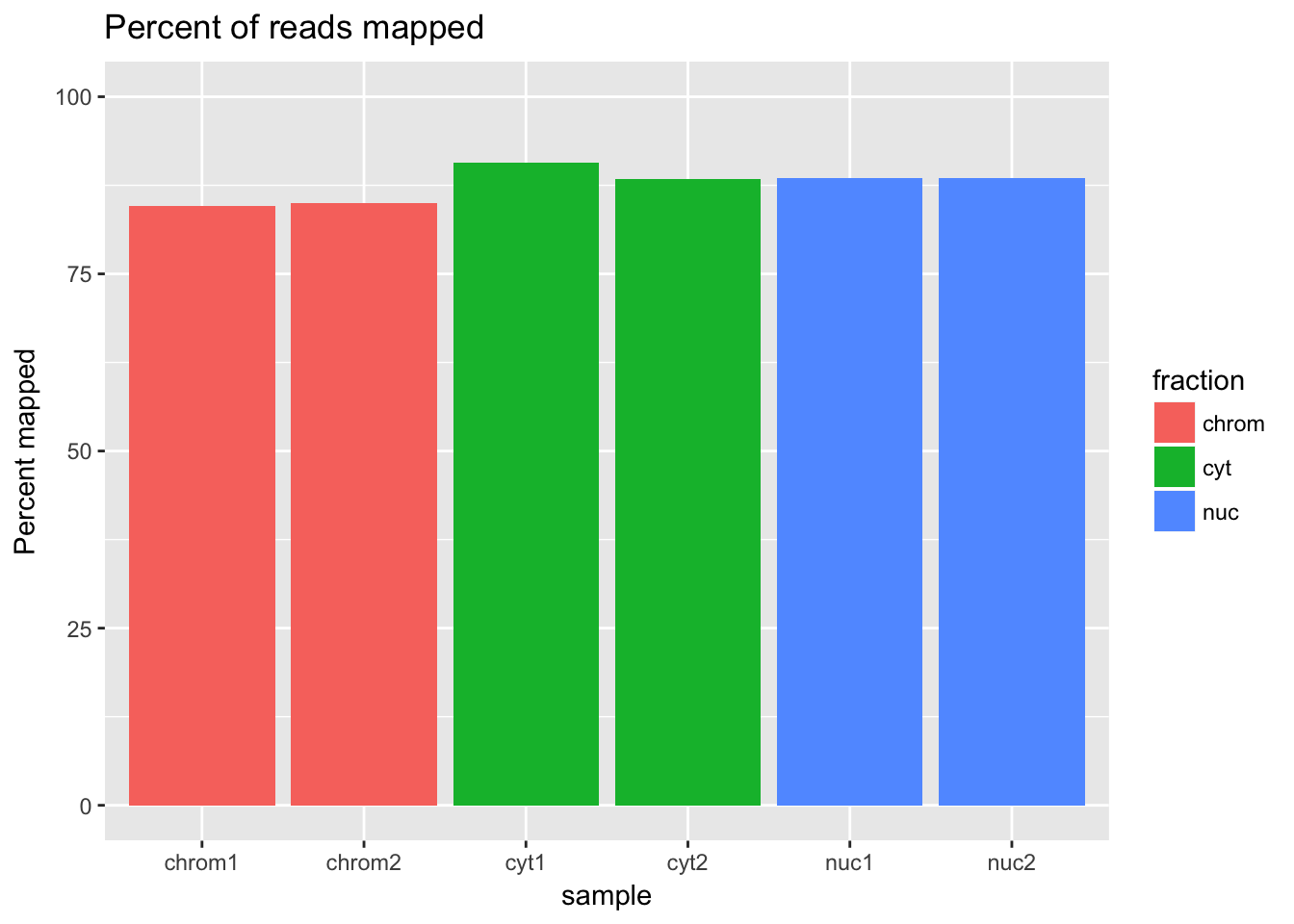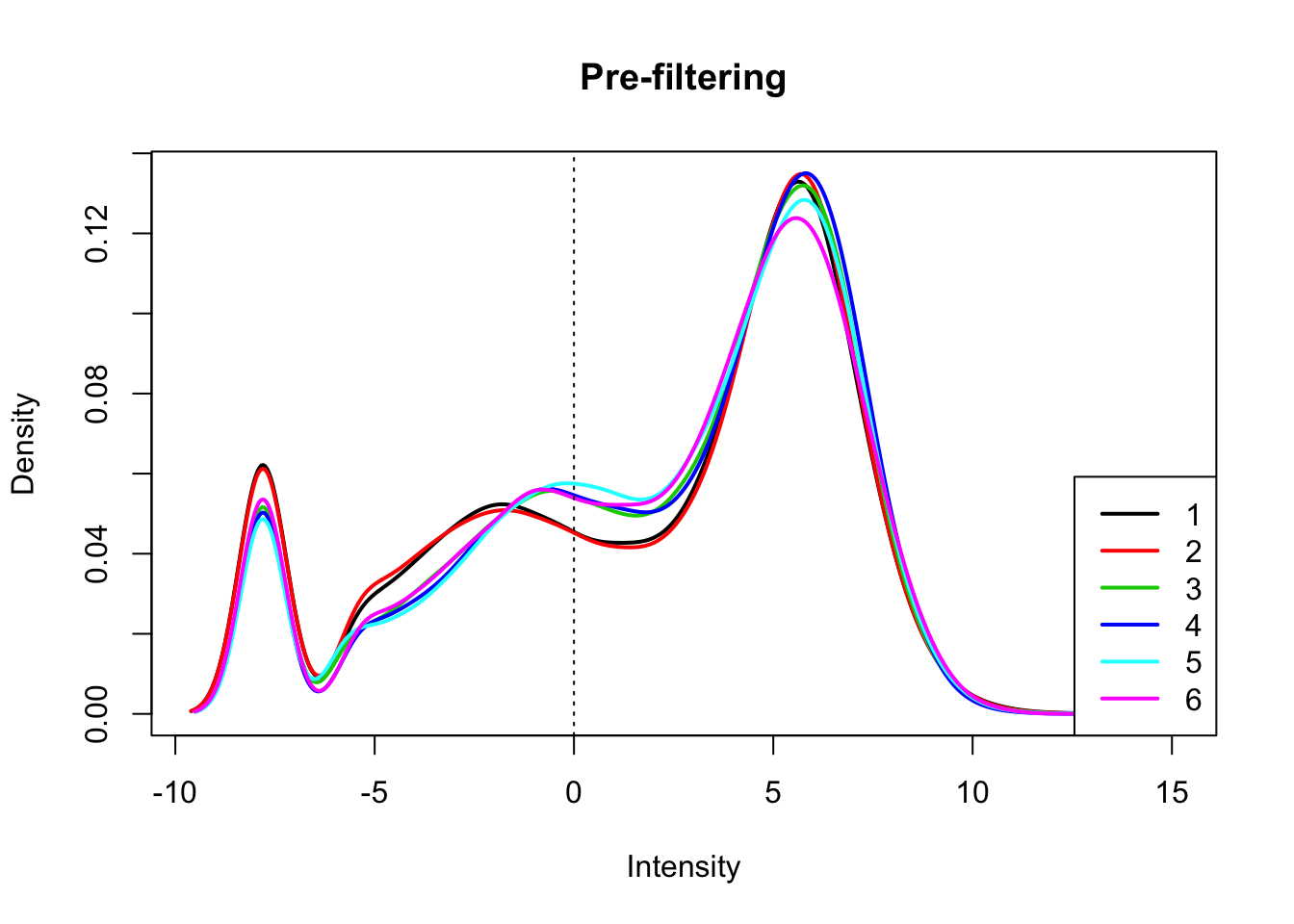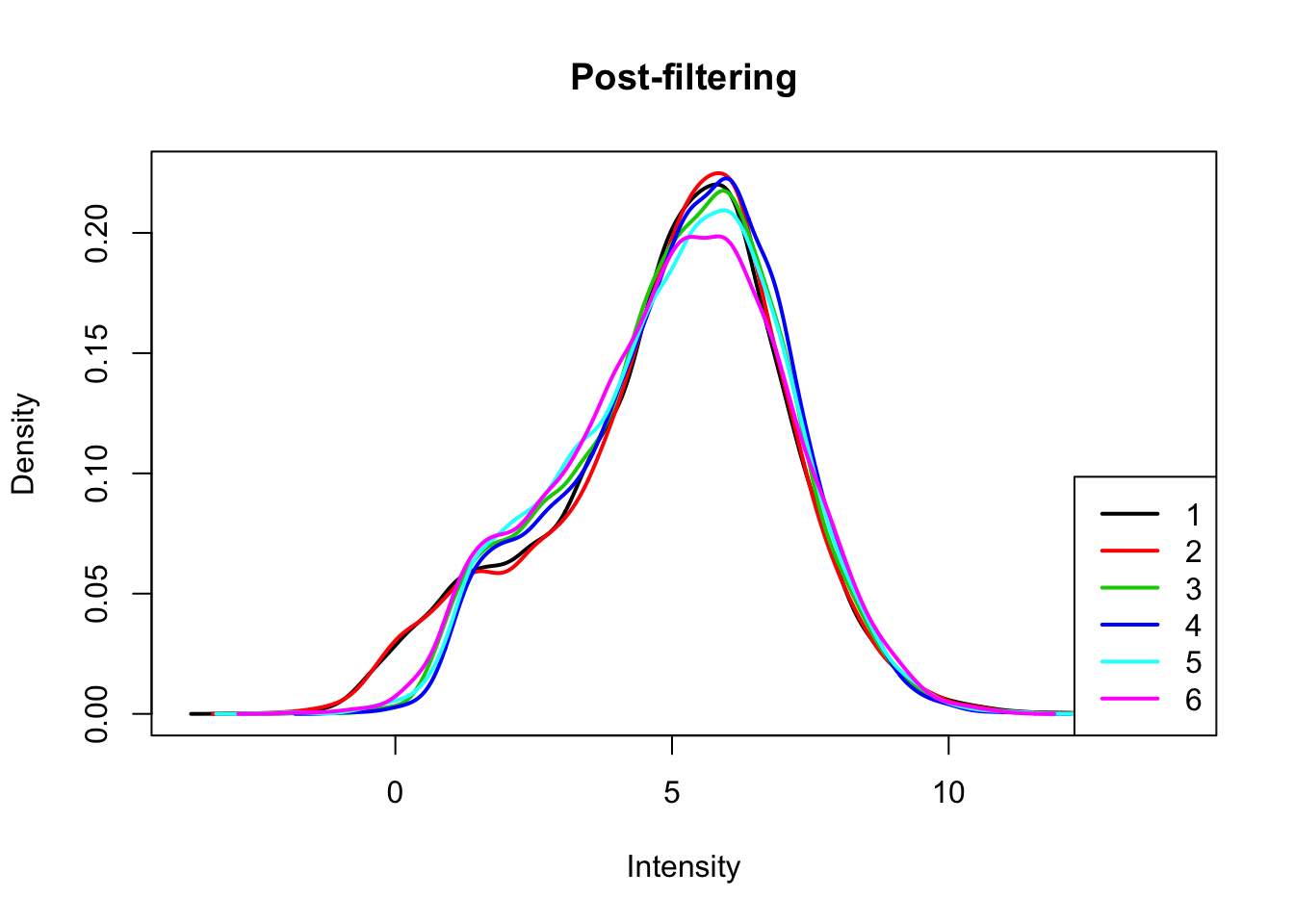Total and Nuclear fraction RNA seq
Briana Mittleman
5/8/2018
I will use this analysis to look at general QC measurements for the RNA seq on the total and nuclear fraction with respect to my three-prime-seq snakemake pipeline.
There are 2 lines with files for chromatin, nuclear and cytoplasmic. There is a sample switch in this anaylsis chrom.2.S3 and Cyt.2.S1 are switched. We know this from a heatmap analysis.
Library
library(ggplot2)
library(dplyr)##
## Attaching package: 'dplyr'## The following objects are masked from 'package:stats':
##
## filter, lag## The following objects are masked from 'package:base':
##
## intersect, setdiff, setequal, unionlibrary(edgeR)## Warning: package 'edgeR' was built under R version 3.4.3## Loading required package: limma## Warning: package 'limma' was built under R version 3.4.3library(workflowr)## Loading required package: rmarkdown## This is workflowr version 1.0.1
## Run ?workflowr for help getting startedlibrary(reshape2)## Warning: package 'reshape2' was built under R version 3.4.3Mapped reads
First I want to look at the number of reads that map. I will flip the sample swap for this analysis so it it correct.
#wc -l file / 4
read_chrom1=74784589
read_chrom2= 56100500
read_nuc1= 73481177
read_nuc2= 60386733
read_cyt1= 63641411
read_cyt2= 61957677Now look at how many reads mapped:
#samtools view -c -F 4 file
map_chrom1=67829422
map_chrom2=49619272
map_nuc1= 65023318
map_nuc2= 53445556
map_cyt1=53856948
map_cyt2=52630632Percent mapped per line:
perc_map_chrom1= map_chrom1/read_chrom1 *100
perc_map_chrom2=map_chrom2/read_chrom2 * 100
perc_map_nuc1=map_nuc1/read_nuc1 * 100
perc_map_nuc2= map_nuc2/read_nuc2 * 100
perc_map_cyt1=map_cyt1/read_cyt1 * 100
perc_map_cyt2=map_cyt2/read_cyt2 * 100Put this information in a dataframe to plot it:
percmap=c(perc_map_chrom1,perc_map_chrom2,perc_map_nuc1,perc_map_nuc2,perc_map_cyt1, perc_map_cyt2)
fraction=c("chrom", "chrom", "nuc", "nuc", "cyt", "cyt")
sample=c("chrom1", "chrom2", "nuc1", "nuc2", "cyt1", "cyt2")
percmap_df=as.data.frame(cbind(sample,fraction, percmap), stringsAsFactors = F)
percmap_df$percmap= as.numeric(percmap_df$percmap)
ggplot(percmap_df, aes(y=percmap, x=sample, fill=fraction)) + geom_col() + scale_y_continuous(limits=c(0,100)) + labs(y="Percent mapped", title="Percent of reads mapped") This shows that mapping is a little bit higher for the cytoplasmic and nuclear fractions than for the chromatin fraction.
This shows that mapping is a little bit higher for the cytoplasmic and nuclear fractions than for the chromatin fraction.
Gene count analysis:
Import gene count data. I will fix the sample switch at this point.
cov_chrom1=read.table("../data/total.nuc.cyt.genecounts/gene_covYG-SP20-Chrom-1_S3_L005_R1_001-genecov.txt", stringsAsFactors = FALSE)
names(cov_chrom1)=c("chr", "start", "end", "gene", "score", "strand", "count" )
cov_chrom2=read.table("../data/total.nuc.cyt.genecounts/gene_covYG-SP20-Cyt-2_S4_L005_R1_001-genecov.txt", stringsAsFactors = FALSE)
names(cov_chrom2)=c("chr", "start", "end", "gene", "score", "strand", "count" )
cov_nuc1=read.table("../data/total.nuc.cyt.genecounts/gene_covYG-SP20-Nuc-1_S2_L005_R1_001-genecov.txt", stringsAsFactors = FALSE)
names(cov_nuc1)=c("chr", "start", "end", "gene", "score", "strand", "count" )
cov_nuc2=read.table("../data/total.nuc.cyt.genecounts/gene_covYG-SP20-Nuc-2_S5_L005_R1_001-genecov.txt", stringsAsFactors = FALSE)
names(cov_nuc2)=c("chr", "start", "end", "gene", "score", "strand", "count" )
cov_cyt1= read.table("../data/total.nuc.cyt.genecounts/gene_covYG-SP20-Cyt-1_S1_L005_R1_001-genecov.txt", stringsAsFactors = FALSE)
names(cov_cyt1)=c("chr", "start", "end", "gene", "score", "strand", "count" )
cov_cyt2=read.table("../data/total.nuc.cyt.genecounts/gene_covYG-SP20-Chrom-2_S6_L005_R1_001-genecov.txt", stringsAsFactors = FALSE)
names(cov_cyt2)=c("chr", "start", "end", "gene", "score", "strand", "count" )Look at the distribution of the gene counts. To do this I need to make a matrix with gene by sample to give the cpm command.
count_matrix=cbind(cov_chrom1$count, cov_chrom2$count, cov_nuc1$count, cov_nuc2$count, cov_cyt1$count, cov_cyt2$count)
gene_length=cov_chrom1 %>% mutate(genelength=end-start) %>% select(genelength)
gene_length_vec=as.vector(gene_length$genelength)
count_matrix_cpm=cpm(count_matrix, log=T, gene.length=gene_length_vec )Plot the distribution of the log cpm counts.
plotDensities(count_matrix_cpm, legend = "bottomright", main="Pre-filtering")
abline(v = 0, lty = 3)
I will only keep genes that have a log cpm greater than 1 in at least 3 samples.
keep.exprs=rowSums(count_matrix_cpm>1) >=3
count_matrix_cpm_filt= count_matrix_cpm[keep.exprs,]
plotDensities(count_matrix_cpm_filt, legend = "bottomright", main="Post-filtering")
Create boxplots:
#pre standardization
colnames(count_matrix)=sample
boxplot(count_matrix, main="Raw Counts by library")
#prefilt
colnames(count_matrix_cpm)=sample
boxplot(count_matrix_cpm, main="Log CPM Counts by library prefilter")
#filtered
colnames(count_matrix_cpm_filt)=sample
boxplot(count_matrix_cpm_filt, las=2,main="Log CPM Counts by library filtered") This shows that we do not need to do any extreme normalization. I will skip it for this initial analysis.
This shows that we do not need to do any extreme normalization. I will skip it for this initial analysis.
Now I can look at the number of genes detected in each sample according to this filtering practice. I will use >1 log cpm for “detected”.
detected_chrom1=sum(count_matrix_cpm_filt[,1] > 1)
detected_chrom2=sum(count_matrix_cpm_filt[,2] > 1)
detected_nuc1=sum(count_matrix_cpm_filt[,3] > 1)
detected_nuc2=sum(count_matrix_cpm_filt[,4] > 1)
detected_cyt1=sum(count_matrix_cpm_filt[,5] > 1)
detected_cyt2=sum(count_matrix_cpm_filt[,6] > 1)Plot these values like the percent mapped.
detected_vec=c(detected_chrom1, detected_chrom2, detected_nuc1, detected_nuc2, detected_cyt1, detected_cyt2)
det_df=as.data.frame(cbind(sample,fraction, detected_vec), stringsAsFactors = F)
det_df$detected_vec= as.numeric(det_df$detected_vec)
ggplot(det_df, aes(y=detected_vec, x=sample, fill=fraction)) + geom_col() + labs(x="Sample", y="Number of detected genes", title="Number Detected genes >1 log-cpm") + scale_y_continuous(limits=c(0,20345))
total_genes=20345
det_df_prop= det_df %>% mutate(prop_det=detected_vec/total_genes)
ggplot(det_df_prop, aes(y=prop_det, x=sample, fill=fraction)) + geom_col() + labs(x="Sample", y="Proportion detected genes", title="Proportion Detected Genes >1 log-cpm") + scale_y_continuous(limits=c(0,1))
Cluster analysis
Create a correlation matrix between the counts.
cor_function=function(data){
corr_matrix= matrix(0,ncol(data),ncol(data))
for (i in seq(1,ncol(data))){
for (j in seq(1,ncol(data))){
x=cor.test(data[,i], data[,j], method='pearson')
cor_ij=as.numeric(x$estimate)
corr_matrix[i,j]=cor_ij
}
}
return(corr_matrix)
}
count_cor=cor_function(count_matrix_cpm_filt)
rownames(count_cor)=sample
colnames(count_cor)=sampleReshape correlation matrix and plot it.
melted_count_corr=melt(count_cor)
ggheatmap=ggplot(data = melted_count_corr, aes(x=Var1, y=Var2, fill=value)) +
geom_tile() +
labs(title="Correlation Heatplot")
ggheatmap
This is the expected plot. The data clusters by fraction and the total and nuclear are more similar than the chromatin fraction.
Density across genes
My snakefile has a rule collecting metrics with the picard tool. I used the data to make a plot of the normalized read density accross gene bodies.

Normalized reads accross gene bodies
Due to sample switch. The total is actually chromatin and the chromatin samples are actually the total samples.
This R Markdown site was created with workflowr